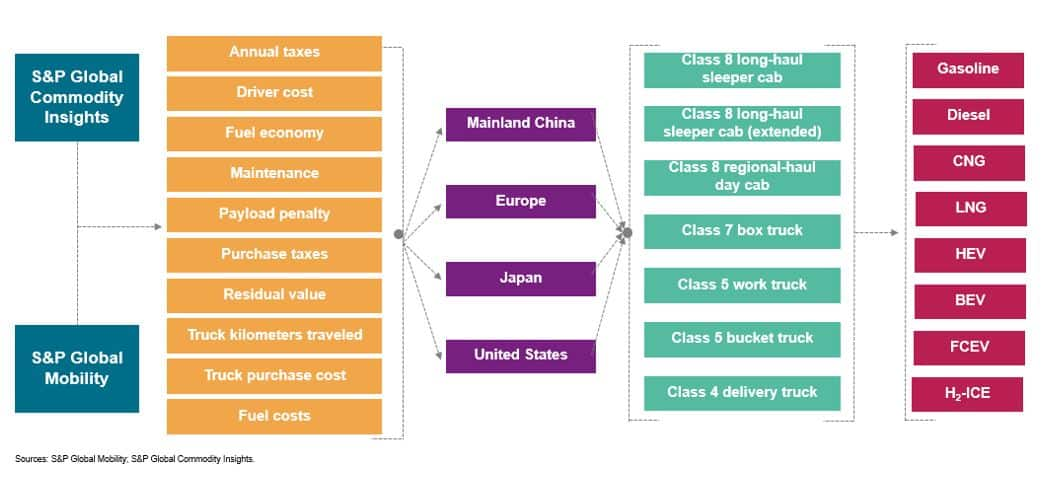Discover more about S&P Global's offerings
Customer Logins
Obtain the data you need to make the most informed decisions by accessing our extensive portfolio of information, analytics, and expertise. Sign in to the product or service center of your choice.
Customer Logins
NEWSLETTER
Mar 28, 2024
Fuel for Thought: The Road to Transformation - Charting the course for the future of trucking
Listen to this Fuel for Thought Podcast
Discover Insights from S&P Global's Report: Reinventing the Truck 2023
Around the world, disruption is coming to the medium and heavy commercial vehicle (MHCV) industry. An increased focus on climate change, strict regulations, and technological innovations are expected to change the future of this industry. In the 2023 Reinventing the Truck (RTT) update, experts from S&P Global Mobility and S&P Global Commodity Insights have partnered to identify and address major questions facing the industry. This report navigates a landscape in flux. Growing optimism for electrified vehicles is weighed against the backdrop of practical challenges. S&P Global's scenario-based approach strives to strike a delicate balance between the two. Updates this year focus on improved prospects for natural gas and hybrid trucks and challenges around the infrastructure buildout for the MHCV energy transition, among other things.
Background
As governments worldwide depend on zero-emission vehicles (ZEV) to meet climate and energy goals, trucking will undoubtedly play a significant role in the upcoming energy transition. Though medium and heavy commercial trucks represented less than 4% of on-road vehicle sales in 2023 (excluding three-wheelers), according to our Commodity Insights Team, they account for 39% of road transport liquids demand and 40% of on-road CO2 emissions, respectively. This report examines the impact of changes in technology and regulations on truck demand, propulsion trends, powertrain shifts, energy demand, and regional climate goals over the next three decades. It focuses on mainland China, Europe, Japan, and the United States. The RTT report presents two forecast scenarios to 2050: Inflections and Green Rules. Inflections represents a continuation of the status quo, where balancing decarbonization ambitions must be weighed equally against adoption constraints. Green Rules, on the other hand, is an alternative scenario that envisions a strong energy transition driven by increased focus on climate change and technological advancements. In this scenario, the clean energy revolution transforms the MHCV fuel mix.
Inflections: Balancing MHCV decarbonization ambitions with practical challenges
- Around the world the adoption of battery-electric and fuel-cell electric MHCVs varies in pace, and catalysts for change will occur gradually.
- In some markets, the zero-emission vehicle (ZEV) sales share is expected to accelerate compared with forecasts published 12 months ago.
- Diesel alternatives will extend beyond ZEVs, with natural gas and hybridization also expected to contribute to the future powertrain mix.
- Downside risks to the ZEV forecasts are considered, and any changes in the political landscape and proposed regulations are top of mind.
- Government policies and initiatives jump-start investment activity, but their success is not yet certain.
Green Rules: A clean energy revolution transforms the MHCV fuel mix
- Market forces and investment activity signal significant acceleration in zero-emission alternatives. Governments will continue to support the energy transition with new funding opportunities combined with the implementation of new regulations.
- Countries around the world vigorously pursue the energy transition to create a competitive edge in the global marketplace.
- Increased demand for clean technology will prompt a robust market response, leading to increased supply and lower prices.
- OEM investments and industry innovation strongly pivot toward ZEVs.
Additional insights into the new questions we answered and drivers of change established in the latest RTT report are included below. We also offer a glimpse into key outcomes from the long-term forecast and discuss our tracking of energy transition signposts, highlighting the key conclusions of this year's report, which is now available for subscribers.
Exploring catalysts for change and answering new questions
Each year, as we discuss a new Reinventing the Truck study, we reflect on key developments and milestones from the past 12 months. We also anticipate looming trends and catalysts for change that are on the horizon, this year's report was no exception.
- Alternatives such as natural gas and most notably hybrid electric vehicles (HEVs) show higher forecasts compared with previous RTT reports. The sales share of HEVs increased due to strong pressure to comply with upcoming regulations, concerns about potential battery raw material shortages, high costs of ZEVs and, in many cases, underdevelopment of the ZEV ecosystem.
- Battery cost (dollars per kilowatt-hour) forecasts in our MHCV TCO have been increased. The TCO forecast uses notably higher battery costs compared with last year's study. Potential shortage of raw materials, lack of economies of scale, competition with the Light Vehicle market, and uncertainty with long-term partnerships are main reasons for this new cost assumption. However, regional differences are important to note, we expect lower battery costs in mainland China compared to other markets.
- Costs or savings of the ZEV adoption were closely examined, identifying major challenges and signposts. OEMs cannot afford to subsidize the purchase costs of ZEVs. Support to alleviate cost burdens would be a key signpost to track. Government support and potentially higher costs for end consumers will help offset these elevated expenses.
- Regulations in Europe and the United States are complicating operations and strategic decisions for global OEMs. Recent changes aim to promote cleaner diesel trucks and electrification, but they come with additional costs and complexity for internal combustion engines (ICEs) and the broader ecosystem.
- In some areas of the global truck market, the ZEV sales share in the Inflections scenario is expected to accelerate compared with forecasts published 12 months ago. A variety of new product launches, the introduction of new regulatory policies and the launch of initiatives focused on supporting decarbonization are all reasons for this increase. However, it is important to point out that these increases are somewhat targeted, with the biggest coming in the late 2020s and early 2030s led by battery-electric vehicles (BEVs) and fuel-cell electric vehicles (FCEVs) in the United Sates and Europe. By 2050, the increases are less noticeable in favor of a more optimistic view on hybridization and natural gas compared with last year.
- Investment in ICE and corresponding improvements in fuel efficiency differ by scenario. In the Green Rules scenario, OEMs somewhat abandon their investment in ICE technology, resulting in two outcomes. First, OEMs rely almost exclusively on ZEVs to comply with upcoming regulations. Second, this trend accelerates the total cost of ownership (TCO) parity between zero-emission vehicles and ICE vehicles.
- Signposts are documented and are key to the ZEV adoption in each scenario. This study assesses key signposts in the Inflections and Green Rules scenarios. It also evaluates necessary trends and developments required for these forecasts to materialize, encompassing the tracking of costs, product availability, regulations, infrastructure deployment and other pertinent factors.
- The infrastructure for battery-electric and hydrogen-powered trucks is complex and requires significant investment. The report provides insights into the challenges of zero -emission MHCV infrastructure and presents potential scenarios for its implementation. For instance, by 2030, the US may need to have 60,000 to 100,000 MHCV chargers available to accommodate our BEV forecast, depending on charger utilization. In the 2040s, the US is projected to have one of the largest hydrogen trucking fleets in the world. To minimize costs, it will be essential to maximize the utilization of hydrogen refueling stations. By the end of this decade, an estimated 4,000 to 11,000 hydrogen refueling stations will be needed for MHCVs in the US, depending on station utilization.
The TCO forecast is central to the Reinventing the Truck study. It provides detailed insights and enables more informed long-term powertrain forecasting. Given the narrow profit margins in many sectors of this industry, market participants are highly sensitive to changes in the cost structure of their purchases.

The scenario-based approach is also evident in the total cost of ownership modeling and forecasting. In the Inflections Scenario, which - represents a continuation of the status quo, - the cost and availability of new technology gradually improve throughout the forecast horizon, but cost remains a significant barrier to adoption throughout the mid-term. Conversely, in the Green Rules Scenario, market forces and investment trends favor decarbonization, resulting in rapid improvements in cost and availability. A tipping point is reached where the cost of new technology significantly drops, making zero -emission alternatives the more economically viable solution. A commonality between the two scenarios is that we have not observed any signals indicating a significant reduction in the cost outlook for zero -emission technology or zero -emission trucks compared to our view from 12 months ago. Limited economies of scale, developing supply chains, and an overall underdeveloped ecosystem suggest that costs will continue to remain high in the immediate future. Staying on the topic of signposts, qualitative assessment in areas like partnerships and technology pathways played a pivotal role in evaluating the future cost metrics of electrified trucks.
Key takeaways include:
- Different MHCV segments will likely adopt various battery chemistries based on operating needs.
- Strategic sourcing decisions by OEMs and suppliers will be a cornerstone of their electrification plans.
- Early signs suggest that MHCV OEMs are leaning towards partnering and outsourcing all aspects of battery procurement, strong partnerships are expected to emerge.
- Global OEMs continue to invest and test hydrogen technology and, -OEMs are creating partnerships to invest in the future.
- In both scenarios, a dual ZEV strategy is expected to emerge; as OEMs development BEVs and hydrogen powered trucks.
- According to the TCO forecasts, costs develop differently for different vocations and in different regions.

Fueling the future of the commercial truck market
Assessing midterm and long-term powertrain forecasts relies on key pillars, including the regulatory environment, total cost of ownership forecasts, and industry signposts such as product availability and investment trends. Achieving a balance between OEM expectations, government ambitions, and S&P Global research and analysis is a crucial part of the RTT forecasts.
In the RTT markets—mainland China, Europe, Japan, and the US—short- to midterm sales trends will be influenced by global economic and geopolitical factors, as well as impending regulations that could alter buying patterns. Long-term, growth in truck sales will be partly offset by a modal shift in freight movement, increased efficiency in the trucking ecosystem and, in certain markets, a slightly weaker economic outlook. As it relates to powertrain changes, over the past 24 months there has been significant momentum to decarbonize the trucking industry, with varying levels of motivation across different regions. For those more familiar with the light vehicle market, trucking stands out for its significance to the global economy by its movement of goods and the expectation of a future with two distinct zero-emission options: battery-electric and hydrogen. It is also important to note that cleaner alternatives such as natural gas trucks and hybridization should not be disregarded. The adoption of zero-emission and electrified trucks will move at different speeds across different regional markets. Key messages that inform the long-term powertrain forecast are noted below.
- Mainland China's transition towards a
different fuel and propulsion mix will be propelled by government
regulations, policies, and investments aimed at reducing reliance
on fossil fuels and meeting climate objectives. Battery-electric
trucks are poised to become a preferred solution due to favorable
TCO economics compared to ICE trucks. Mainland China benefits from
its large market size and strong government support for developing
the ZEV ecosystem. In both scenarios, the convergence of low
battery costs, affordable manufacturing, and the inefficiency of
diesel trucks allows various truck vocations to quickly achieve
parity in TCO between battery-electric vehicles and diesel.
Compared to our view from 12 months ago, the absence of new, more
stringent regulations and other indicators suggests that the
forecast for electrified trucks in mainland China remains largely
unchanged. The adoption of zero-emission trucks is expected to
gradually strengthen as the overall ZEV ecosystem improves.

- Europe's ambitious goal to decarbonize the
transport sector ranks among the strongest globally. However,
initial adoption is expected to be somewhat modest in our
Inflections scenario as impending regulations and policy targets
begin to take shape in the late 2020s and into the 2030s. Europe's
CO2 reduction regulations will heavily influence mid- to
long-term powertrain forecasts, with compliance varying across
different scenarios. These forthcoming regulations are anticipated
to significantly impact the future of this market. Compared to our
view last year, the electrification outlook through the early 2030s
will remain largely unchanged, despite a notable increase in the
sales share of HEVs. Additionally, an elevated outlook for
electrified trucks in the 2040s is expected due to OEMs adhering to
anticipated EU CO2 reduction regulations. In the Green
Rules scenario, ZEV sales are projected to see a significant
increase to meet regulatory requirements.
- Japan exhibits a robust commitment to
hydrogen, evident in the involvement of key OEMs such as Toyota,
Honda, Isuzu, and Mitsubishi, all engaged in various levels of FCEV
investment and product launches. In addition, several OEM
partnerships are emerging in Japan and the impact of new
partnerships on the market can be interpreted in various ways.
Collaboration, cost-sharing, and any efforts to enhance economies
of scale can be viewed as a positive for the market. However, with
lack of aggressive regulations or ZEV mandates, adoption of BEVs
and FCEVs in this market will be lower compared with other RTT
markets. However, in the Green Rules scenario, improved TCO
economics of ZEVs will be enough to drive significant demand in the
mid to long-term forecast horizon. In the Inflections scenario, two
major drivers of ZEV growth are absent: stringent regulations and a
TCO structure that would encourage higher ZEV adoption.
- United States market changes can be seen as policy driven. In recent years, the current administration has shown a steadfast commitment to reducing and potentially eliminating emissions from the transportation sector. The passage of several large spending bills, incorporating climate change initiatives, coupled with the introduction of new regulations has escalated the pressure on the industry to reduce emissions to unprecedented levels. However, there are significant downside risks to consider. Uncertainties around energy costs and product costs loom large, as do domestic and international political risks, which could impact public support or raw material availability, for example.

Overall, the uptake ZEVs in the US will follow this trend; first demand will be driven by the regulatory environment and subsidies before TCO of ZEVs reaches parity with ICEs. In the US, the Inflections scenario suggests that the market will experience a dual strategy to electrify the trucking industry. Increasing pressure to comply with imminent regulations and initiatives stemming from the IRA are driving factors behind the rise in sales of HEVs and FCEVs, respectively.
The long-term impact on oil demand
The adoption of alternative power sources for medium and heavy commercial trucks will significantly impact the entire logistics ecosystem and economies worldwide. Oil demand will be a metric severely affected. Beyond the obvious uptake of ZEVs, several factors contribute to the decline in oil demand. It's crucial to emphasize that no single reason independently drives demand down; rather, it's the cumulative impact of multiple factors such as:
- The continued improvement in fuel efficiency of diesel-powered trucks. We are in an era especially in the US and Europe, where tightening emission regulations will force OEMs to invest in more fuel-efficient technology.
- Advancements in the trucking and logistics ecosystem are expected to enhance industry efficiency putting downward pressure on the demand to add trucks to the fleet.
- In the long term, growth in truck sales will be partly offset by a modal shift in freight movement toward other modes of transport such as rail or water. This trend will be particularly evident in Europe and mainland China.
- Trucking forecasts are closely tied to economic performance in their local markets. Any slowdown in average gross domestic product (GDP) growth may adversely impact demand to add new trucks to the fleet.
Conclusion
The Reinventing the Truck report unveils two plausible scenarios amidst a changing landscape. The different scenario storylines unfold narratives of how the future market landscape will evolve and how clean energy technology will transform the MHCV fuel mix. Each insight in the report emphasizes a consistent takeaway: change is inevitable.
The report is
available now for subscribers.
Please
contact us for more information on the latest Reinventing the
Truck report!
--------------------------------------------------------------
Dive deeper into these mobility insights:
Gain a new perspective on the commercial vehicle market with Fleet Intelligence
Get a free Truck Model Production Forecast from S&P Global Mobility
This article was published by S&P Global Mobility and not by S&P Global Ratings, which is a separately managed division of S&P Global.
{"items" : [
{"name":"share","enabled":true,"desc":"<strong>Share</strong>","mobdesc":"Share","options":[ {"name":"facebook","url":"https://www.facebook.com/sharer.php?u=http%3a%2f%2fstage.www.spglobal.com%2fmobility%2fen%2fresearch-analysis%2ffuel-for-thought-the-road-to-transformation-charting-the-cours.html","enabled":true},{"name":"twitter","url":"https://twitter.com/intent/tweet?url=http%3a%2f%2fstage.www.spglobal.com%2fmobility%2fen%2fresearch-analysis%2ffuel-for-thought-the-road-to-transformation-charting-the-cours.html&text=Fuel+for+Thought%3a+The+Road+to+Transformation+-+Charting+the+course+for+the+future+of+trucking+%7c+S%26P+Global+","enabled":true},{"name":"linkedin","url":"https://www.linkedin.com/sharing/share-offsite/?url=http%3a%2f%2fstage.www.spglobal.com%2fmobility%2fen%2fresearch-analysis%2ffuel-for-thought-the-road-to-transformation-charting-the-cours.html","enabled":true},{"name":"email","url":"?subject=Fuel for Thought: The Road to Transformation - Charting the course for the future of trucking | S&P Global &body=http%3a%2f%2fstage.www.spglobal.com%2fmobility%2fen%2fresearch-analysis%2ffuel-for-thought-the-road-to-transformation-charting-the-cours.html","enabled":true},{"name":"whatsapp","url":"https://api.whatsapp.com/send?text=Fuel+for+Thought%3a+The+Road+to+Transformation+-+Charting+the+course+for+the+future+of+trucking+%7c+S%26P+Global+ http%3a%2f%2fstage.www.spglobal.com%2fmobility%2fen%2fresearch-analysis%2ffuel-for-thought-the-road-to-transformation-charting-the-cours.html","enabled":true}]}, {"name":"rtt","enabled":true,"mobdesc":"Top"}
]}



